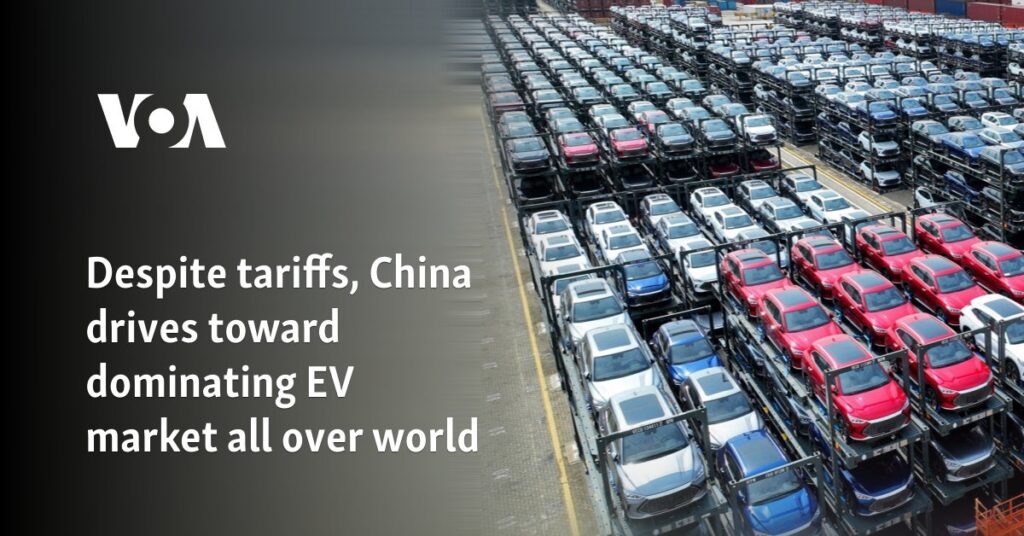Beijing’s drive for global auto dominance continues unabated as it pursues retaliatory measures against the European Union (EU) in response to tariffs on Chinese-made electric vehicles.
Over the past year, companies like EV giant BYD have expanded into markets from Southeast Asia to Latin America and Africa, even as they face tariffs of up to 100% in Canada and the United States and up to 45% in India. european union.
The Chinese EV company announced plans to invest millions of dollars to build new factories in Thailand and Brazil, and opened showrooms in Zambia, Kenya and South Africa.
And while most Chinese EV makers say they will continue selling cars in Europe and won’t raise prices to offset the tariffs, analysts say they may also sell cars in developing markets as well. He says it makes sense to focus more on that.
Ryan Berg, director of the Americas program at the Center for Strategic and International Studies, said the EV market is like a fully inflated balloon.
“When countries like the United States, the European Union, and Canada squeeze[the balloons]the air goes somewhere else. Well, the air now goes to developing countries that don’t impose tariffs.” It’s a Chinese car,” Berg said.
Bangkok, Brazil, Ethiopia
In Thailand, companies like Great Wall and BYD are leading the way. BYD opened a production facility in Thailand in July, and company chairman Wang Chuanfu said BYD has already captured 40% of the EV market. Earlier this year, Great Wall Motors became the first Chinese EV company to mass-produce electric vehicles overseas through its production facility in Thailand.
In addition to Thailand, BYD has also gained significant market share in Singapore and Malaysia. The EV giant ranks as Singapore’s second most popular car brand by sales in the first half of 2024, according to government figures. BYD ranks among Malaysia’s top 10 car brands after BMW and Mercedes-Benz when compared to all registered vehicles.
In Latin America, BYD has begun a partnership with Uber and plans to provide 100,000 Chinese-made EVs to Uber drivers around the world. Additionally, BYD plans to open a new car factory in eastern Brazil in 2025. Both BYD and Great Wall have local R&D, production and sales centers in Brazil.
John Helveston, an assistant professor of engineering management at George Washington University, said that from a business perspective, it makes sense for Chinese EV companies to move to markets where there is more room for profit.
“So these companies, like BYD, are global companies in the same way that you have Toyota and GM and Ford and Volkswagen,” Helveston told VOA. “They want to expand like any successful business.”
Paul Nanturia, a China expert at the Africa Center for Strategic Studies at the National Defense University in Washington, said Africa offers a huge market opportunity for Chinese EV companies.
However, that opportunity comes with challenges. Like other countries, Africa still lacks EV infrastructure such as charging stations.
Nantulla, who attended the Forum on China-Africa Cooperation (FOCAC), said China and Africa are building long-term relations, especially in the green energy and EV sectors.
He said: “Since the last FOCAC, 122 green energy projects have been implemented and between 2021 and 2024, 122 green energy projects will be implemented in 40 countries on the African continent. “It’s huge and it’s stable.” V.O.A.
“China’s state-owned enterprises in this field are very active in developing economies. As you know, the rate of rise in their technology in Africa is very high,” he said.
In March, China partnered with Ethiopia to announce an ambitious plan to transition to electric mobility. The plan aims to introduce nearly 500,000 electric vehicles to Ethiopia over the next 10 years.
mutual benefit
All three analysts said Beijing’s penetration of global markets is being facilitated by the economic benefits it offers in return. For example, Helveston said many countries are willing to “leverage market access” in exchange for infrastructure and technology improvements.
Chinese companies are building roads, trains, schools and hospitals in some of the world’s poorest countries, and developing countries see the auto trade as simply building on relationships that have already existed for some time. He said there are. “It’s a very transactional relationship.”
CSIS’s Berg said Latin American countries are “enthusiastic about Chinese investment in technology industries, including the EV industry.” He noted that Latin American countries view the EV industry as “highly reliable” and “rich in employment opportunities.”
Nanturya added that Chinese technology is seen as a way to help African countries deal with energy issues such as power outages.
“From an African perspective,[China’s presence]is contributing to the diversification of Africa’s energy grid, which is an important issue. It is also contributing to improving Africa’s energy mix,” Nanturya said. said.
He said China has taken an aggressive approach in building large-scale infrastructure projects in developing countries, but the United States has yet to embark on projects of a similar scale.
“I think we’re going to see quite a big change in the global landscape in, say, 10 years. … Many of these countries may be much more comfortable working with China than they are with the United States,” Helveston said. said. Said.
But Washington is not sitting idle. At the 2022 U.S.-Africa Summit, the United States pledged $55 billion over three years, including investments in renewable energy infrastructure, clean energy, and climate change mitigation efforts.
Berg said geopolitics is also motivating Beijing’s expansion into developing countries in South America.
“They are in geopolitical competition (with the United States), they are engaged in reciprocity, and in some ways they can be very active, especially in the economic sphere of our immediate neighbourhood,” he said. It shows,” he said.



